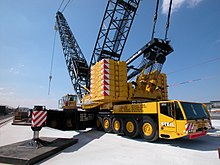Derrick boom

A derrick boom is installed on large cranes that are supposed to lift a very large load. Derrick booms can be found on almost all large lattice boom cranes, both truck-mounted and crawler cranes. It is very rare in telescopic cranes.
The construction is named after the English executioner Thomas Derrick .
functionality
The derrick boom is mounted behind the main boom of a crane and, in contrast to this, is directed backwards during operation. Usually the main boom head is adjustable on the derrick boom. This is in turn connected to the weight bracket (A-frame). The forces are transferred from the boom head via the tip of the derrick boom and the A-frame to the superstructure and the superstructure ballast. In this way, the boom is braced much better than if the boom is directly connected to the A-frame, since the angle between the main boom and bracing is significantly larger. This has a positive effect on long booms and z. With long lattice booms it is sometimes only possible to set up the main mast with a derrick boom.
In the case of heavy lifting operations, a platform floating just above the ground is attached to the head of the derrick boom using long steel cables or rods. A large amount (up to a few hundred tons) of additional, so-called suspended ballast , can be placed on this. The ballast platform partly rests on a movable carriage. Due to the enormous additional ballast and the large ballast radius, the crane is able to achieve significantly higher load values, especially with large outreaches.
disadvantage
Buying a derrick boom is a huge additional investment. The space requirement of the crane increases both in use and in storage. Time is lost due to the additional effort during assembly.
Using a suspended ballast is complicated. If the suspended ballast platform is not supported on the ground with wheels, the crane can only hold the suspended ballast in the air if a sufficiently large load is attached. Before the load is separated from the crane, the suspended ballast must be lowered to the ground and, if necessary, moved by an auxiliary crane so that the ballast can be attached again at the next lift after the load has been attached to the hook.


